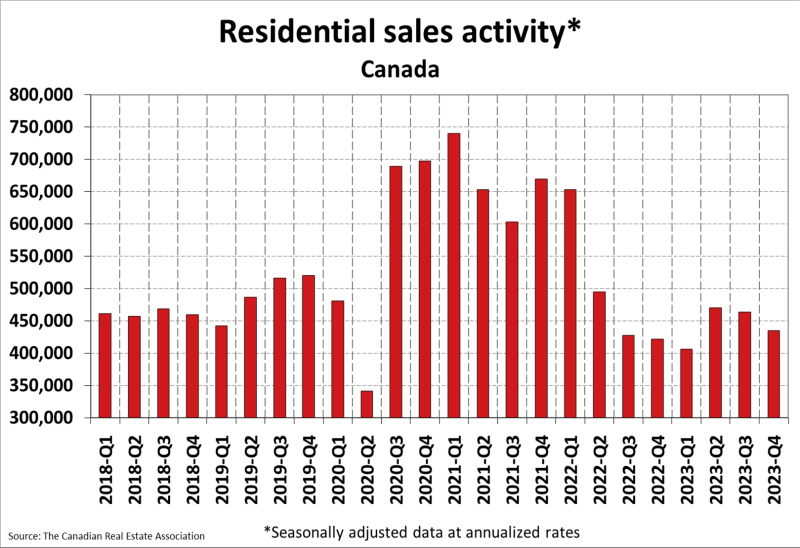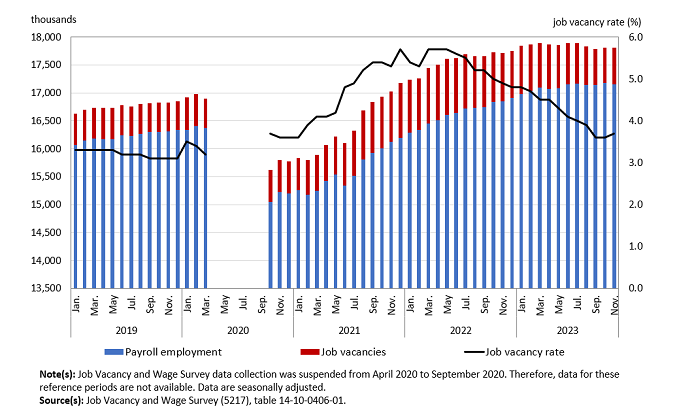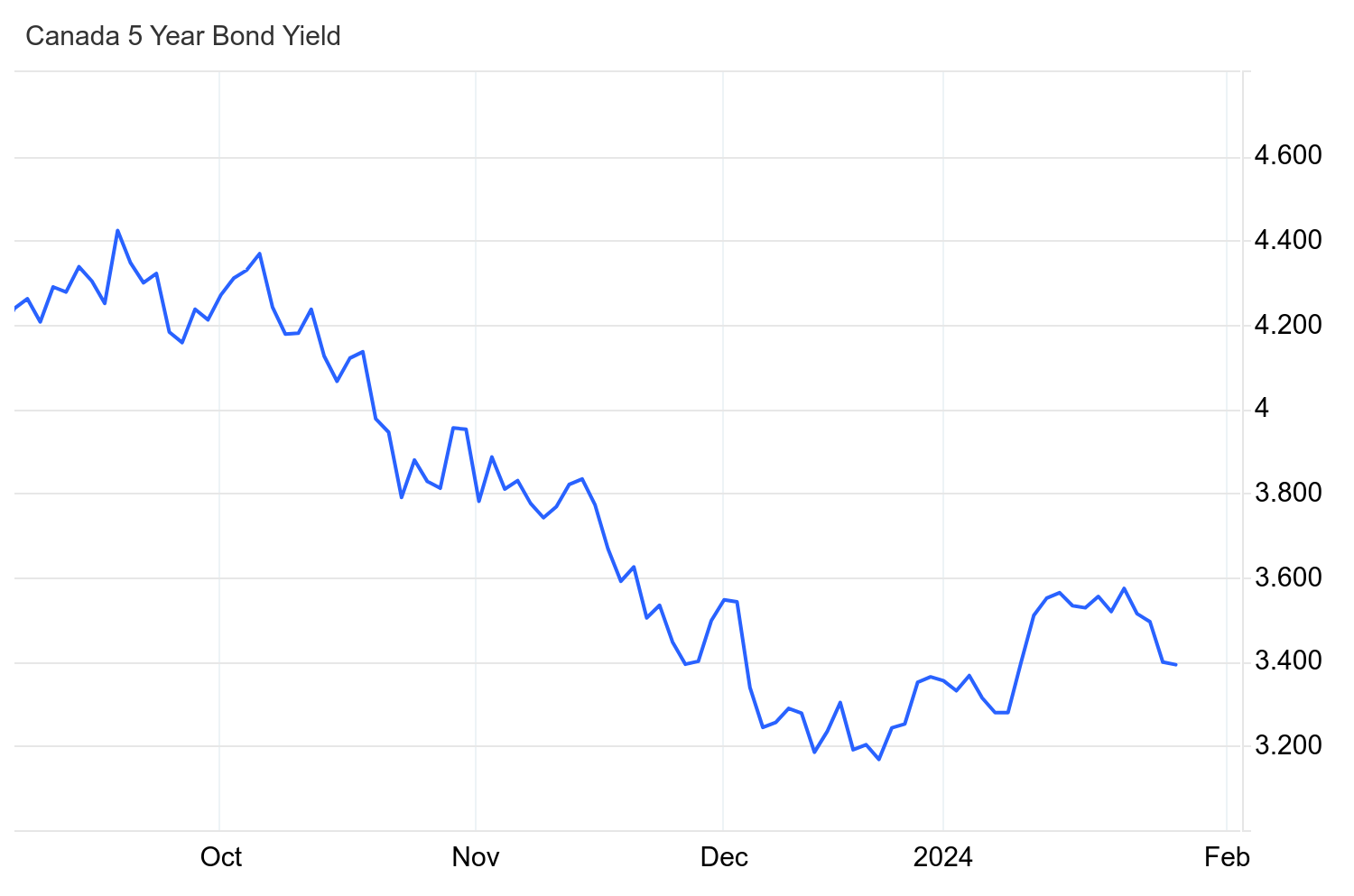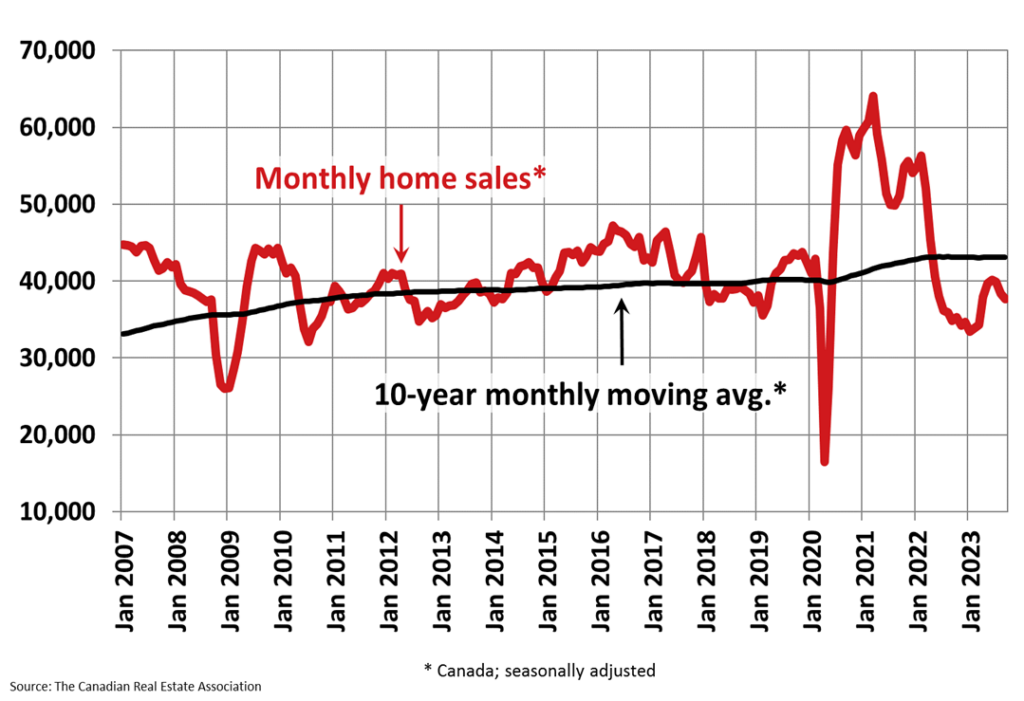Read the 2024 interest rate forecast.
Save money on your mortgage
Don’t leave money on the table
Don’t just go with your bank
Get today’s best rates from our lenders
On January 24th, The Bank of Canada published their decision to continue to hold their Policy interest rate at 5.00%. With 4 consecutive rate holds, markets and the Central Bank believe there is clear evidence pointing to slowing demand and increased probability of a technical recession, lead by slower consumption growth and a decline in housing activity, while still maintaining their hawkish and precautionary stance. Markets and Senior Economists are largely convinced there are no more rate hikes in the pipeline for Canadians and expect the first rate drop to come as soon as Q2. The Central Bank projects the economy will continue to cool down, bringing inflation back to its two per cent target some time in early 2025.
Commentary from Perch’s CEO and Principal Mortgage Broker, Alex Leduc:
Rate cuts have been pushed out a quarter in 2024 and the long-term interest rate has risen by roughly 0.50% (meaning 2 less cuts than previously expected). This seems to be mainly driven by inflation in December that was higher than expected. Borrowers should still see over 1.75% in rate cuts by end of 2025, which will be highly anticipated by the bulk of mortgages maturing in 2025/2026.
Key Takeaways
- The Bank of Canada has paused rate hikes for the time being, with the next announcement scheduled for March 6th.
- For the month of February, we anticipate fixed rates will drop and variable rates will remain the same.
- Today’s best mortgage rates are 4.94% for 5-year fixed and 6.00% for 5-year variable.
- For first-time home buyers, there are some great opportunities, sellers are coming to terms with tapering price growth as higher interest rates have barred many from entering the market, inventory is low, but will edge up in the early months of 2024, before really ramping up in the Summer.
- For homeowners who are coming up for renewal, continue to monitor our rate forecasts, it would be wise to see what rates Perch may be able to offer above and beyond your existing Lender, as they’re typically less aggressive on their rate offerings.
- For homeowners who would like to see the benefit of switching lenders and breaking their mortgage early, Perch automatically calculates the net benefit once you input your existing property and mortgage details in your Perch portfolio.
What’s new in the mortgage world for February?
For the month of February, we anticipate fixed rates will drop and variable rates will remain the same. National sales activity jumped 8.7% in December, however, annually sales in 2023 were down 11.1% from 2022, the lowest on record since 2008. Canada’s inventory edged down by 5.1% month over month in December, the lowest inventory levels since June. The sales-to-new listings ratio was 57.8% in December, versus a ratio of 49.8% in November, in comparison, this ratio peaked at 67.9% in April. According to Shaun Cathcart, CREA’s Senior Economist, the upswing in sales and tighter sales to new listing ratios was an anomaly, “It was more likely just some of the sellers and buyers that were holding onto unrealistic pricing expectations last fall finally coming together to get deals done before the end of the year. We’re still forecasting a recovery in housing demand in 2024, but we’ll have to wait a few more months to get a sense of what that ultimately looks like.”
The Aggregate Composite MLS Home Price Index edged down by 0.8% on a month-over-month basis in December, however it is up 0.7% year-over-year. The actual (not seasonally adjusted) national average home price was $657,145 in December, up 5.1% year over year.

The Bank of Canada is continuing to hold interest rates steady
On January 24th, The Bank of Canada published their decision to continue to hold their Policy interest rate at 5.00%. With 4 consecutive rate holds, markets and the Central Bank believe there is clear evidence pointing to slowing demand and increased probability of a technical recession, lead by slower consumption growth and a decline in housing activity, while still maintaining their hawkish and precautionary stance. Markets and Senior Economists are largely convinced there are no more rate hikes in the pipeline for Canadians and expect the first rate drop to come as soon as Q2. The Central Bank projects the economy will continue to cool down, bringing inflation back to its two per cent target some time in early 2025.
The strength of the Canadian economy
Canada’s real gross domestic product was up 0.2% in November, after three consecutive months that were essentially unchanged. Services-producing industries edged up 0.1%, while goods-producing industries lead the charge with an increase of 0.6%. Q3 negative GDP data released on November 30th shows that on an annualized basis, the Canadian economy contracted at a rate of 1.1%. Stats Canada advance information indicates that real GDP increased 0.3% in December, meaning the economy expanded 0.3% in the fourth quarter, and 1.5% for 2023 as a whole. While this technically means Canada is not yet in a recession, as we have not yet had two consecutive contracting quarters, growth stalled, remaining essentially unchanged and coming in well below expectations. The central Bank forecasts GDP growth of 0.8% in 2024 and 2.4% in 2025, roughly unchanged from its October projection.

Key Terms:
GDP: GDP or Gross Domestic Product refers to the total dollar amount of goods and services produced in a country. It is an overall measure of the strength of our economy.
CPI: The CPI or Consumer Price Index is a measure of inflation tracked by Statistics Canada. It attempts to track the spending habits of the average consumer with a basket of typical goods and services.
Consumer price index (CPI)
December consumer price index, the measure for year over year inflation, came in at +3.4%, following November’s +3.4%, a result of the base-year effect since gasoline prices fell more on a monthly basis in December 2022 than they did in December 2023. Excluding gasoline, the headline CPI slowed year over year, from 3.6% in November to 3.5% in December. Canadians continued to battle elevated shelter costs (+6%) and mortgage interest costs (+28.6%) in December and beyond, notably, mortgage interest rates has been and continues to apply the highest upward pressure on the CPI since December of 2022. The Central Bank sees tightening household discretionary spending as their most viable tool to halt consumer spending on goods and services and attain their 2% inflation target, the CPI should drop below the 3% mark in early 2024, the next slated CPI announcement will be on February 20th.

Job vacancies and Unemployment Rates (new report will be out on Feb 9)

Strong population growth continues to fuel demand
Canada’s population saw an increase of 430,635 (+1.1%), from July to October 2023, the highest growth rate Canada has experienced in any Quarter since the baby boom, in 1957 (+1.2%). Strong population growth continues to add both demand and supply to the Canadian economy, newcomers are helping ease the shortage of workers while also boosting consumer spending and driving up demand for housing. Ottawa plans to level out the number of new immigrants it accepts in 2026, however will maintain their goal of attracting 500,000 newcomers annually in both 2024 and 2025. Many arriving in Canada’s major markets are searching for shelter amidst the home unaffordability crisis, driving up rental cost (+7.7%) in December. Provinces rely heavily on Canadian investors to supply rental apartments in the form of investment homes, however, as higher interest rates and mortgage costs have worked to deter existing and would be landlords, the supply of rentals has steadily declined which has driven up rents across the country.
Recommended reading: How does population affect the housing market?
Bond yields move downwards
Canada’s 5-year bond yields have continued to move downward since they reached 16-year highs during the month of October. Canada’s mortgage rates tend to track five-year bond yields at a premium and with a lag. Yields dropped due to a growing consensus that interest rates remaining elevated long than anticipated and a hard Canadian recession fear all but diminished as the Canadian economy is now expected to be in a mild recession after a negative Q3 and flat Q4 results.

If you’re looking to buy a home in Canada:
Our current best 5-year fixed rates is 4.94% and 5-year variable rate of 6.00%.
For first-time home buyers, there are some great opportunities, sellers are coming to terms with tapering price growth as higher interest rates have barred many from entering the market, inventory is low, but will edge up in the early months of 2024, before really ramping up in the Summer.
For homeowners who are coming up for a mortgage renewal, continue to monitor our rate forecasts, it would be wise to see what rates Perch may be able to offer above and beyond your existing Lender, as they’re typically less aggressive on their rate offerings.
For homeowners who would like to see the benefit of switching lenders and breaking their mortgage early, Perch automatically calculates the net benefit once you input your existing property and mortgage details in your Perch portfolio.
 Ali
Ali







